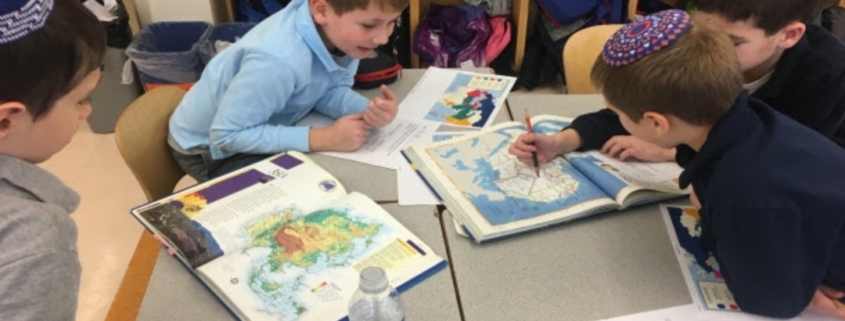Where Are the Tests? Assessment in Grades K-5 at Schechter Manhattan
Special guest columnists this week: Shira Jacobson, Curriculum and Programming Coordinator, and Deanna Stecker, Coordinator of Learning Support
Parents often ask, “How will teachers know what their students have learned if there are no tests?” Even though we don’t administer many tests, we carefully and consistently assess our students in all grades and subject areas.
Consider the following scenes from some of our classrooms:
The kindergarten class has just completed a unit in math. One of the teachers is sitting at a table with a small group of students, playing a math game. If you look closely, you can see that she is taking notes on a chart about each student in the group and how they are responding to her questions and participating in the game. After a few minutes, a new group comes to the table so that all students have an opportunity to participate in this activity.
It is reading workshop time in the first-grade classroom. A teacher is sitting on the side with one student, listening to the student read, noting all of the errors and self-corrections that the student makes, and then asking a variety of comprehension questions to check for understanding. She uses the information she collected to determine that he would benefit from working in a small group that is learning strategies for reading multisyllabic words.
The second-grade students are preparing their Community Map presentations, the culmination of their Community theme unit. Students are working in groups, creating their own maps and legends and writing the scripts of what they will say. They are using a rubric with a list of expectations for the project. Teachers are circulating, listening to conversations, guiding students in their collaboration, and talking through the students’ questions. They will use the same rubric to evaluate the students when they present their maps the following day.
The fourth grade is just beginning the portfolio process. Students work independently as they carefully looking through the completed work they have collected over the past few months and determining the progress each piece shows. They are deciding whether each piece reflects skills mastered, ongoing progress, or an area that needs more work. Teachers are conferencing with the students as they self-evaluate and reflect on their work. The teachers then help them articulate the progress they have made and next steps in their learning. These reflections are the basis for the student-led portfolio conferences in the spring.
These scenes illustrate just some of the assessment that goes on in our classrooms every day. At Schechter Manhattan, we are committed to understanding each child and helping them grow as thinkers and learners. Ongoing, authentic assessment of our students’ mastery of skills and content, and the use of that information to inform future instruction, are crucial tools to support that growth. This assessment process is complex and relies on a variety of approaches.
The three forms of assessment we use are:
- Formative – ongoing assessments of student comprehension, learning needs and academic progress during a lesson or unit that help teachers improve instruction and student learning.
- Summative – assessments that evaluate student learning, skill acquisition and academic achievement at the end of a lesson or unit.
- Self-evaluative – student reflections of their own academic progress, completed work and learning.
Traditional testing, a summative style for assessing student progress, is rarely used in our school. We prefer to use varied forms of summative assessments such as final presentations, published writing pieces, or a culminating project. Just like tests, these summative assessments give the teachers an accurate picture of the child’s mastery of skills and content. In contrast to traditional tests, however, these assessments require our students to actively engage with the material in a way that promotes individual choice and student ownership in demonstrating the extent of their learning.
Formative assessment is the cornerstone of our approach to teaching and learning. Teachers are always observing, listening, reviewing classwork and homework, and engaging with students in order to gain a deeper understanding of each child’s response to instruction and growth in knowledge and skills. Our collaborative teaching model allows for ongoing conversations about these observations and ways to improve instruction in order to best meet the needs of all our students. Additionally, our students receive regular feedback from teachers, orally and in writing, so they can begin to understand who they are as learners and be active participants in their education. This prepares the students to self-evaluate their work, skills, and progress in order to set goals and determine a path for their own success.
Shabbat Shalom,
Shira Jacobson and Deanna Stecker



